The attainment gap between poor and wealthy children has remained “stubbornly large” in secondary schools despite billions in targeted funding, an analysis of social mobility progress over two decades has found.
A report by the Social Mobility Commission today has warned that government efforts to improve social mobility have failed to deliver enough progress in reducing the gap in Britain’s “have and have nots”.
Researchers analysed progress made in four life stages – from early years, schools, training and further education, and work. Each area was rated on a traffic light scale – with none scoring a green (the best rating). Schools were rated as amber.
The report found that despite reforms to schools and success in improving results, two thirds of children on free school meals still don’t get good GCSEs.
While there has been “significant progress” in reducing the attainment gap in primary school, there has been little progress closing the gap at secondary.
The report adds that there is “currently no prospect” of this gap being eliminated at GCSE – despite billions being given to schools every year in pupil premium funding.
The Social Mobility Commission has now called on the government to introduce a new “ambition” that the attainment gap will be closed within a decade.
The commission also called for a more “balanced curriculum”, to include social and emotional learning, alongside careers advice, in the formal school timetable.
Alan Milburn, chair of the Social Mobility Commission, said: “A new geographical divide has opened up, a new income divide has opened up and a new generational divide has opened up.
“If we go on like this, these divisions are set to widen, not narrow… The policies of the past have brought some progress, but many are no longer fit for purpose in our changing world. New approaches are needed if Britain is to become a fairer and more equal country.”
Schools Week has rounded up the key findings on what progress has been made in education over 20 years:
1. Attainment gap closed ‘significantly’ at primary…
The report found that, since 2006, attainment has risen by almost one-fifth in reading and writing for free school meal pupils.
For reading, the attainment gap was reduced by almost half between 2006 and 2015, and in writing and maths it reduced by a third (see image below).
The social commission stated the narrowing gap follows a “sharper focus” on mastering literacy and numeracy at an early stage.
This was boosted by the introduction of the pupil premium in 2011, where schools get an extra £1,320 per disadvantaged pupil – playing a “significant role”.

2. …But it remains ‘stubbornly large’ at secondary
While there has been an increase in attainment among both free school meal, and non-free school meal pupils – the gap remains at 28 percentage points in secondary.
The report noted there had been “no real narrowing of the gap over the last two decades”, adding that an attainment gap increasing “during a child’s time in education shows that schools are not the engines of social mobility they should be”.
(Worth noting – there is a caveat over comparability issues with the data, after changes such as qualification reforms and only first exam attempts counting in GCSE results.)
The attainment gap between 19-year-olds achieving two or more A-levels is 22 percentage points, only a “minimal improvement” on 11 years earlier, the report stated.
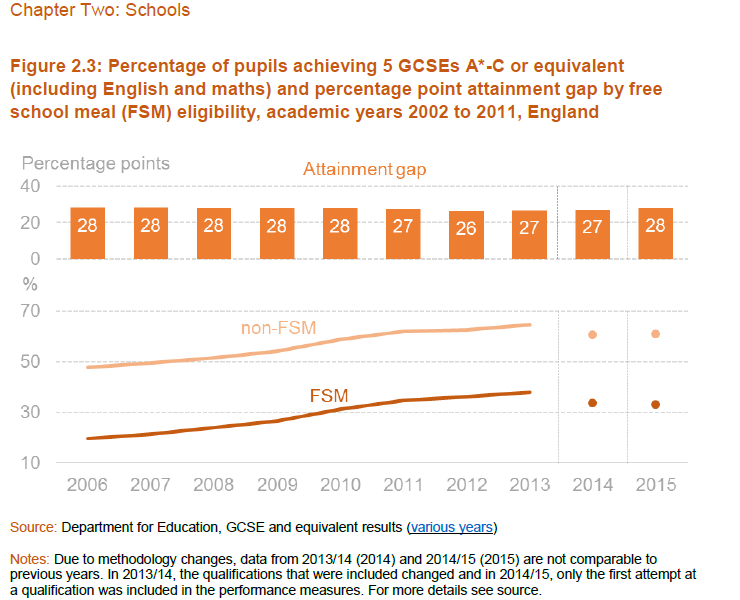
3. Schools in big cities follow London in pulling away from rest
The report found the gap between attainment of free school meal pupils in the best and worst regions has increased by 10 percentage points.
While London was strides ahead, there has also been “systematically better performance” in other large cities such as Birmingham and Manchester (also with high numbers of poor pupils) – pushing up the progress of the west midlands, and north west regions since 2002 (see image).
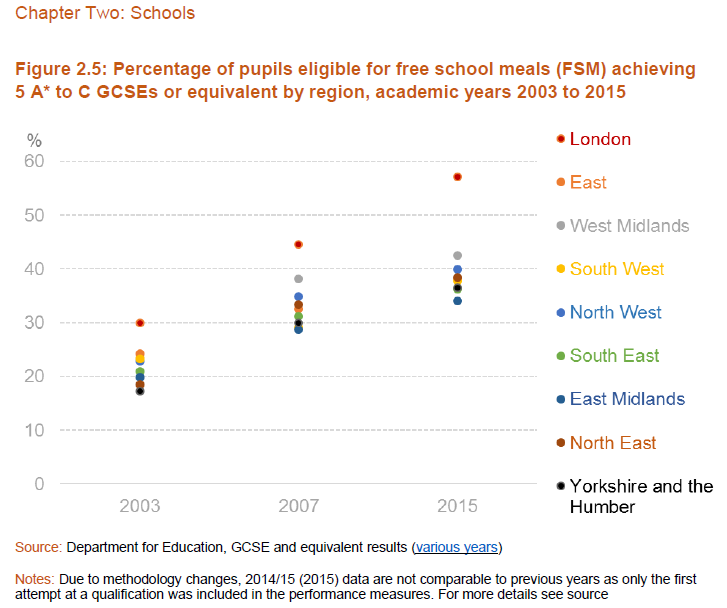
4. Funding for education IS falling
The Social Mobility Commission report found that a political focus on education saw spending increase by 50 per cent in real terms between 1997 and 2014.
But it has not increased since reaching a high of £99 billion in 2010-11, and has infact decreased since then.
This is something many teachers regularly point out when the government maintains it is delivering “record funding levels” in schools.
Note: this is because the government has maintained the same level of funding per-pupil – as there are more pupils in the system, the amount it pays for schools overall is more than ever. BUT, this doesn’t account for the extra pressure squeezing school budgets – IE upped employer pension contributions. (Hence why the Social Mobility Commission has looked at ‘real terms’)
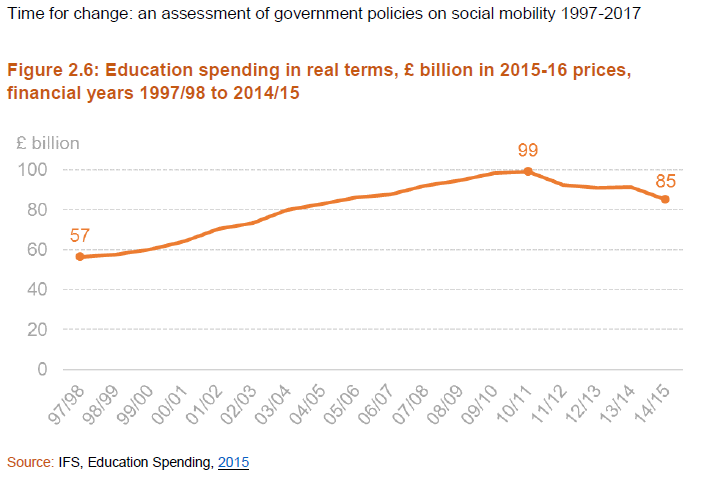
5. Teacher quality ‘single biggest educational factor’ affecting attainment
The Social Mobility Commission has flagged numerous concerns over teacher recruitment and retention. (Click here for an in-depth round-up of the biggest issues)
The report blames the increasing number of teachers leaving the profession to low morale resulting from a loss of professional autonomy, and increased workload – with particular concerns raised over huge regional disparities over access to good teachers.
And things don’t look to be getting any better. Schools Week reported last week the new teacher rate was at its lowest in five years.
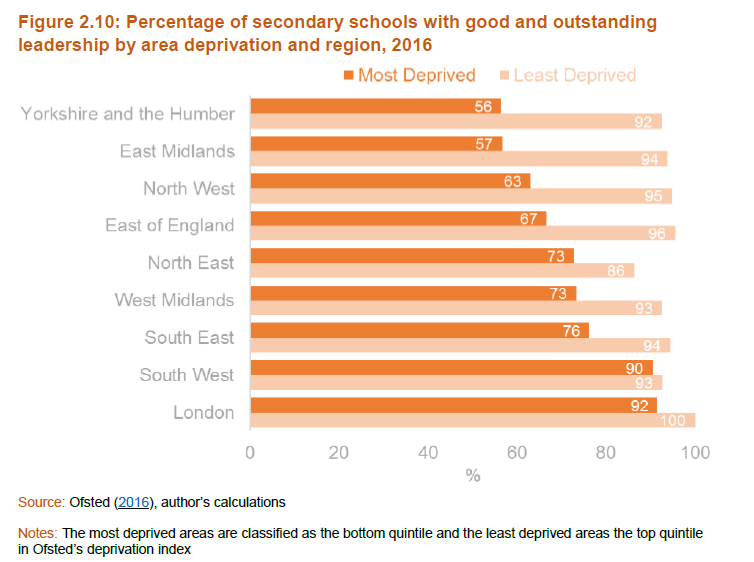
6. So, how has the government done in boosting social mobility in schools?
The Social Mobility Commission ruled that four education policy areas (out of 10) are rated ‘red’ – attainment gap at both GCSE and A-level, regional equality in free school meal attainment, and fostering and social and emotional development. The full list is here:
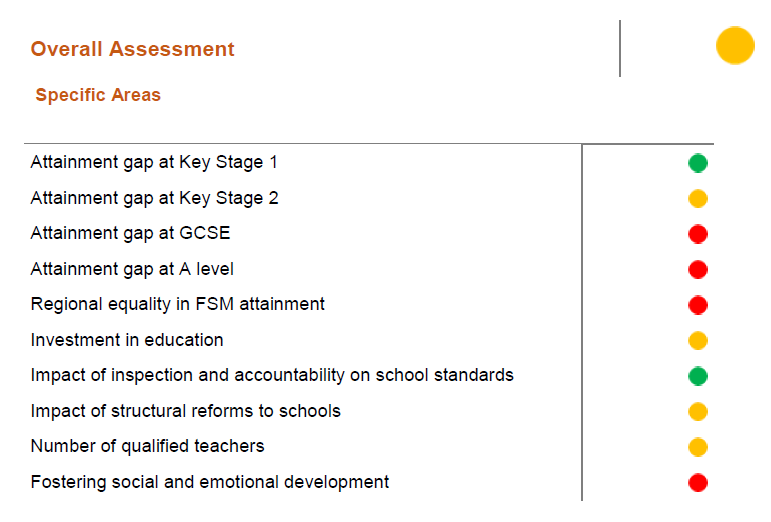
7. What the Department for Education said:
“Tackling social mobility is at the heart of the government’s ambition to make Britain a country that works for everyone.
“There are 1.8 million more pupils in good or outstanding schools than in 2010, and we are delivering three million apprenticeship places, opening up access to our higher education system and investing £500 million a year into technical education.
“However, we know that more must be done, and that’s why last year we launched our £72 million Opportunity Areas programme. This is bringing together local businesses, schools and councils in 12 social mobility ‘coldspots’ to create better opportunities for young people.”



Your thoughts